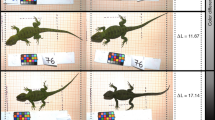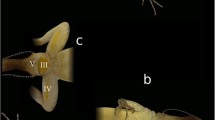Abstract
Sexual selection theory and game theory posit that cues to mate quality and fighting ability should be costly to be honest. Male sand lizards (Lacerta agilis) consider a rival's nuptial coloration when making strategic decisions in contests, and in this paper I examine five mechanisms (both proximate and ultimate ones) that could constrain male nuptial coloration. Three of these mechanisms were rejected as potential constraints on male nuptial coloration: testosterone, predation, and parasites. Two mechanisms could not be rejected as constraints on male pigmentation: differential allocation of energy to reproduction versus somatic growth among males, and social costs due to high aggression from conspecific males.
Similar content being viewed by others
References
Andersson M (1982) Sexual selection, natural selection and quality advertisement. Biol J Linn Soc 17:375–393
Andrews RM (1982) Patterns of growth in reptiles. In: Gans C, Pough FH (eds) Biology of the reptilia, vol 13, Physiology D, Physiological Ecology. Academic Press, London, pp 273–335
Cooper W Jr, Mendoca MT, Vitt LJ (1987) Induction of orange head coloration and aggression by testosterone in the male broad- headed skinkEumeces laticeps. J Herpetol 21:96–101
Endler JA (1980) Natural selection on color patterns inPoecilia reticulata. Evolution 343:76–91
Endler J, Lyles AM (1989). Bright ideas about parasites. Trends Ecol Evol 4:246–248
Grubb TC Jr (1989) Ptilochronology: feather growth bars as indicators of nutritional status. Auk 106:314–320
Hamilton WD, Zuk M (1982) Heritable true fitness and bright birds: a role for parasites? Science 218:384–387
Haskins CP, EF Haskins, McLaughlin JJ, Hewitt RE (1961) Polymorphism and population structure inLebistes reticulatus, an ecological study. In: Blair WF (ed) Vertebrate speciation. Universitiy of Texas Press, Austin, Texas, pp 31–51
Hemelaar A (1985) An improved method to estimate the number of growth year rings resorbed in phalanges ofBufo bufo (L) and its application to populations from different latitudes and altitudes. Amphibia-Reptilia 6:323–341
Howard RD, Minchella DJ (1990) Parasitism and mate competition. Oikos 58:120–122
Kitzler G (1941) Die Paarungsbiologie einiger Eidechsen. Z Tierpsychol 4:335–402
Kodric-Brown A, Brown JH (1984) Truth in advertising: the kinds of traits favored by sexual selection. Am Nat 124:309–323
Kristin A (1987) Uberlappung trophisher Anspruche der NestlingeAsio otus undFalco tinnunculus in den Windbrechern. Biologia Bratislava 42:625–632
Madsen T, Shine R, Loman J, Håkansson T (in press). Determinants of reproductive success in male addersOpera berus. Anim Behav 45:491–499
Maynard Smith J (1982) Evolution and the theory of games. Cambridge University Press, Cambridge
Moller A-P (1987) Social control of deception among status signalling house sparrowsPasser domesticus. Behav Ecol Sociobiol 20:307–311
Nuland GJ van, Strijbosch H (1981) Annual rhythmics ofLacerta vivipara Jacquin andLacerta agilis L. (Sauria, Lacertidae). Amphibia-Reptilia 2:83–95
Olsson M (1984) Spatial patterns and social system in the sand lizard,Lacerta agilis. Honors thesis, University of Göteborg
Olsson M (1992a) Contest success in relation to size and residency in male sand lizardsLacerta agilis. Anim Behav 44:386–388
Olsson M (1992b) Sexual selection and reproductive strategies in the sand lizardLacerta agilis. Ph D thesis, University of Göteborg
Olsson M (in press) Nuptial coloration in the sand lizard (Lacerta agilis): an intrasexually selected cue to fighting ability. Anim Behav
Olsson M (1993) Nuptial coloration and predation risk in model sand lizards,Lacerta agilis. Anim Behav 46:410–412
Olsson M, Silverin B (1992) A green badge in the male sand lizardLacerta agilis: what component of fighting ability does it reflect? In: Olsson M, Sexual selection and reproductive strategies in the sand lizardLacerta agilis. Ph D thesis, University of Göteborg
Ralph CL (1969) The control of color in birds. Am Zool 9:521–530
Read AF (1988) Sexual selection and the role of parasites. Trends Ecol Evol 3:97–102
Reichenbach-Klinke H, Elkan E (1965) Diseases of reptiles. TFH Hong Kong, pp 474–495
Simms C (1970) Lives of British lizards. Goose, London
Smith M (1964) The British amphibians and reptiles. Collins, London, pp 183–192
Stamp-Dawkins M, Guilford T (1991) The corruption of honest Signalling. Anim Behav 41:865–873
Svahn K (1972) Coccidian blood parasites in lacertids. Ph D thesis, Lund
Svahn K (1974) Incidence of blood parasites of the genusKaryolysus (Coccidia) in Scandinavian lizards. Oikos 25:43–53
Svahn K (1976) A new piroplasmSauroplasma boreale sp. n. (Haemosporidia, Theliriidae) from the sand lizard Lacerta agilis. Norw J Zool 24:1–16
Whitfleld DP (1987) Plumage variation, status signalling and individual recognition in avian flocks. Trends Ecol Evol 2:13–18
Zucker N (1988) A method for rapid and precise documentation of lizard coloration. Herpetol Rev 19:13–16
Author information
Authors and Affiliations
Rights and permissions
About this article
Cite this article
Olsson, M. Why are sand lizard males (Lacerta agilis) not equally green?. Behav Ecol Sociobiol 35, 169–173 (1994). https://doi.org/10.1007/BF00167956
Received:
Accepted:
Issue Date:
DOI: https://doi.org/10.1007/BF00167956




